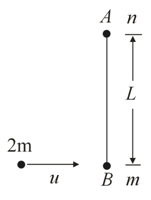Q.
Two small balls $A$ and $B$ , each of mass $m$ , are joined rigidly at the ends of a light rod of length $L$ . They are placed on a frictionless horizontal surface. Another ball of mass $2m$ moving with speed $u$ towards one of the balls and perpendicular to the length of the rod on the horizontal frictionless surface as shown in the figure. If the coefficient of restitution is $\frac{1}{2}$ , then the angular speed of the rod after the collision will be

NTA AbhyasNTA Abhyas 2022
Solution: